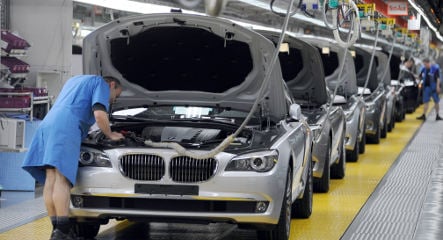The economy ministry said overall output in Europe’s biggest economy leapt by 3.7 percent in May from the previous month and added: “Industrial production may have passed the trough.”
The outlook was also brighter than in April, when production fell by a revised 2.6 percent, a ministry statement said.
On Tuesday, the ministry reported a May surge of 4.4 percent in industrial orders, a leading indicator of future activity.
A breakdown of the output data showed that manufacturing of capital goods, which includes autos, leapt by 8.3 percent in May on the month, partly thanks to a government cash-for-clunkers scheme that pays drivers €2,500 to scrap an old car for a new one.
But “foreign demand for German cars was (also) a key driver as had already been reflected by yesterday’s new orders data,” UniCredit economist Andreas Rees noted.
Commerzbank’s Ralf Solveen underscored the stronger foreign demand for autos as well and said it “is presumably not just due to the government incentives.”
Juergen Michaels at Citi called a 24.2 percent surge in auto sector output “outstanding.”
On a 12-month basis, overall adjusted industrial output nonetheless fell by 17.9 percent, the data showed, a sign of how much the economy has shrunk in a year.
The monthly rise was nonetheless a second piece of good news from the economy ministry, which said Tuesday that industrial orders had leapt higher in May, suggesting the upward momentum in output could be maintained.
Germany is suffering its worst recession since World War II, and the government expects economic activity to shrink by 6.0 percent this year.
Spurring economic growth was a key topic for leaders of the Group of Eight most industrialised countries as they met in the earthquake-struck Italian town of L’Aquila.
“While there are signs of stabilisation, including recovery in stock markets … the situation remains uncertain and significant risks remain to economic and financial stability,” a G8 statement said.
One obstacle is weak bank lending to the private sector, growth of which in the eurozone hit an all-time low of 1.8 percent in April, according to European Central Bank.
Banks seem to be using hundreds of billions of euros, dollars, pounds and yen churned out by central banks to bolster balance sheets rather than to extend credit to the larger economy.
In Germany, many firms complain of tighter credit, and between January and April, more than 10,000 companies declared insolvency according to official data released Wednesday.
Large and small firms that depend on exports have been slammed by the worldwide slowdown, and chemical giant BASF said Tuesday it would slash 3,700 jobs by 2013.
With unemployment on the rise, a key question is whether the marked easing of recessionary pressures will last.
A breakdown of the German output data showed that construction activity fell by 3.2 percent in May from April, and energy production was off by 3.8 percent.
The surge in domestic auto sales could also screech to a halt once state aid is no longer available.
But with falling business inventories seen to be near their lowest level, economists forecast a general turnaround in the coming months.
“The recession in the industrial sector is bottoming out,” ING economist Carsten Brzeski said.
Rees added that “after the summer break, the odds are rising that the German economy will manage a comeback.”



 Please whitelist us to continue reading.
Please whitelist us to continue reading.
Member comments